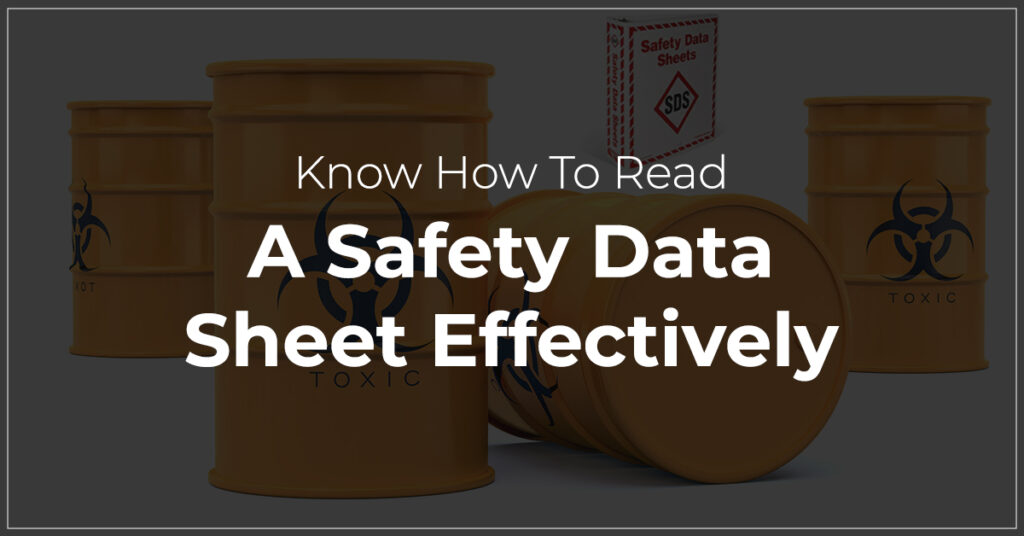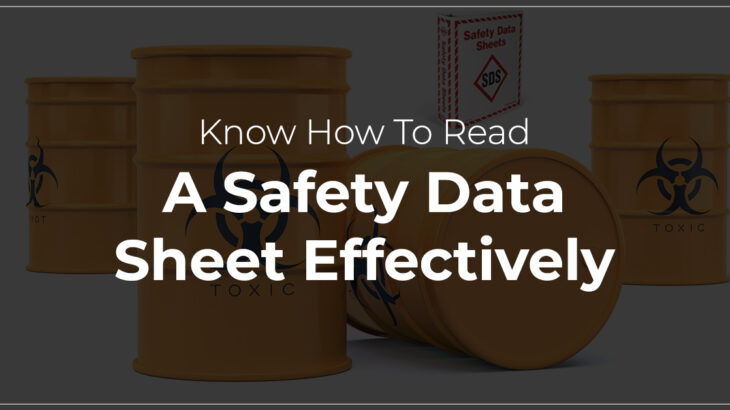
SDS or Safety Data Sheets serve as an comprehensive guide encompassing the critical information regarding the various chemical substances and it’s potential risk in the workplaces especially industries and factories. These documents serve as a vital resource for the employees particularly for the individuals handling various chemical compositions or have extended exposure to the hazardous substances. Hence, we at Sunstream understand the importance of having SDS at the workplace and offer a comprehensive solution through our SDS services, providing easy access to vital safety information for employees. However, it is essential to know how to read the safety data sheets effectively to ensure a safe environment including places such as laboratories, industries, and chemical-oriented workplaces. Therefore, this blog explains the essential things that you should know about how to read a safety data sheet effectively.
Understanding The Sections
As mentioned earlier, SDS is a document that contains information in sixteen sections with each section explaining about the chemical substance. It is essential to familiarize each section to understand the effectiveness and potential of the chemical substance to prevent workplace accidents and its extended exposure. However, it is to be noted that some SDS regulations can vary based on the regional conditions or law, the standard structure for the SDS is discussed below. Therefore, a overview is mentioned below,
Identification:
Provides product identifier, manufacturer information, emergency contact details, and recommended use.
Hazard(s) Identification:
Details the hazards associated with the substance, including potential health effects, physical and chemical properties, and classification under regulatory standards.
Composition/Information On Ingredients:
This section lists the chemical ingredients of the substance, including their concentrations and any impurities present.
First-Aid Measures:
Offers guidance on appropriate first-aid procedures in case of substance exposure or accidents.
Fire-Fighting Measures:
Outlines fire-fighting techniques, extinguishing agents, and hazards associated with fires involving the substance.
Accidental Release Measures:
Provides instructions for containing spills, cleaning up, and mitigating environmental impacts.
Handling & Storage:
Offers guidance on safe handling practices, storage conditions, and compatibility with other substances.
Exposure Controls/Personal Protection:
This section specifies the exposure limits, engineering controls, and personal protective equipment (PPE) required for safe handling.
Physical & Chemical Properties:
Describes the substance’s appearance, odor, pH, solubility, and other relevant physical and chemical characteristics.
Stability & Reactivity:
Discusses the substance’s stability, potential decomposition reactions, and conditions to avoid (e.g., incompatible materials, temperature, pressure).
Toxicological Information:
Summarizes toxicity data, including acute and chronic effects, routes of exposure, and potential health hazards.
Ecological Information:
Provides information on the substance’s environmental impact, including its persistence, bioaccumulative potential, and toxicity to aquatic organisms.
Disposal Considerations:
Offers guidance on safe disposal methods and regulatory requirements for the substance and its packaging.
Transport Information:
Specifies transportation classifications, packing groups, and special precautions for shipping the substance.
Regulatory Information:
Summarizes relevant regulatory information, including hazard classifications, labeling requirements, and regulatory agency contacts.
Other Information:
This section includes additional information not covered in the previous sections, such as revision history, date of preparation, and any relevant references.
Identifying Key Information
Once familiar with the SDS sections, the next step is identifying and extracting critical information relevant to your needs. Here are some tips for effectively navigating an SDS:
Focus On Hazard Identification:
Pay close attention to Section 2 (Hazard(s) Identification), as it outlines the potential hazards associated with the substance, including health effects and physical and environmental hazards.
Review Exposure Controls:
Section 8 (Exposure Controls/Personal Protection) provides crucial information on exposure limits, engineering controls (e.g., ventilation), and recommended PPE (e.g., gloves, goggles) to minimize risks during handling.
Check First-Aid Measures:
Familiarize yourself with the first-aid procedures outlined in Section 4, including appropriate responses to exposure scenarios such as inhalation, skin contact, or ingestion.
Assess Fire-Fighting Measures:
Section 5 (Fire-Fighting Measures) offers essential guidance on extinguishing agents, fire-fighting techniques, and potential hazards associated with fires involving the substance.
Consider Environmental Impact:
Section 12 (Ecological Information) provides insights into the substance’s potential environmental effects, aiding in risk assessment and mitigation strategies.
Note Regulatory Requirements:
Section 15 (Regulatory Information) summarizes relevant regulatory standards and requirements, ensuring compliance with applicable laws and regulations.
Interpreting Hazard Communication
Effective hazard communication is a critical aspect of SDSs, helping users understand and mitigate risks associated with chemical substances. Here are some key elements to consider when interpreting hazard communication in an SDS:
Hazard Classification:
Consider hazard classifications based on regulatory standards such as the Globally Harmonized System of Classification and Labelling of Chemicals (GHS). These classifications indicate the nature and severity of potential hazards.
Hazard Statements:
Hazard statements in Section 2 provide concise descriptions of specific hazards associated with the substance, aiding in risk assessment and communication.
Precautionary Statements:
Precautionary statements offer guidance on safe handling, storage, disposal, and emergency response measures, helping users minimize risks during substance handling and use.
Signal Words & Symbols:
Signal words (e.g., “Danger,” “Warning”) and hazard pictograms convey the severity of hazards visually, enhancing hazard awareness and ensuring effective communication across language barriers.
Utilizing Additional Resources:
In addition to the information provided in an SDS, several resources can enhance your understanding of chemical hazards and safety practices:
Chemical Databases:
Online databases such as the National Institute for Occupational Safety and Health (NIOSH) Chemical Database or the Hazardous Substances Data Bank (HSDB) offer comprehensive information on chemical substances, including toxicity data, exposure limits, and regulatory status.
Regulatory Agencies:
Regulatory agencies such as the Occupational Safety and Health Administration (OSHA) in the United States or the European Chemicals Agency (ECHA) in the European Union provide guidance documents, regulations, and compliance assistance related to chemical safety.
Safety Training Programs:
Participating in safety training programs and workshops on chemical handling and hazard communication can enhance your knowledge and skills in interpreting SDSs and implementing safe practices.
Reading a Safety Data Sheet is crucial for ensuring the safe handling, storage, and use of chemical substances in various environments. By understanding the structure of an SDS and partnering with Sunstream for compliance and workplace safety, you can enhance your ability to assess risks, implement appropriate controls, and protect yourself and others from potential hazards. Continuous education and training in chemical safety practices further reinforce your capacity to navigate SDSs and promote a culture of safety in your workplace or laboratory.




 +1.585.935.7123
+1.585.935.7123 +91-804-148-6861
+91-804-148-6861